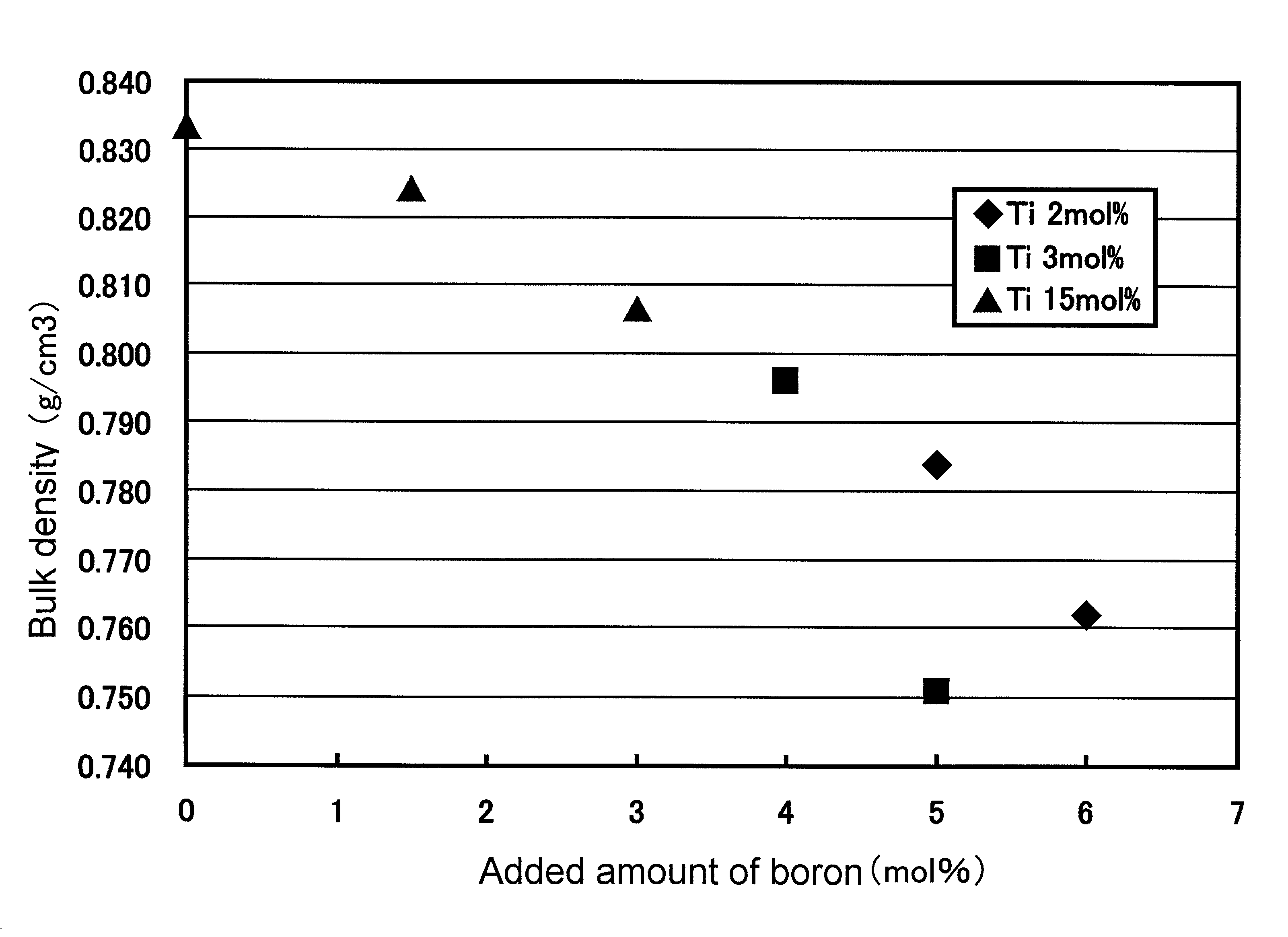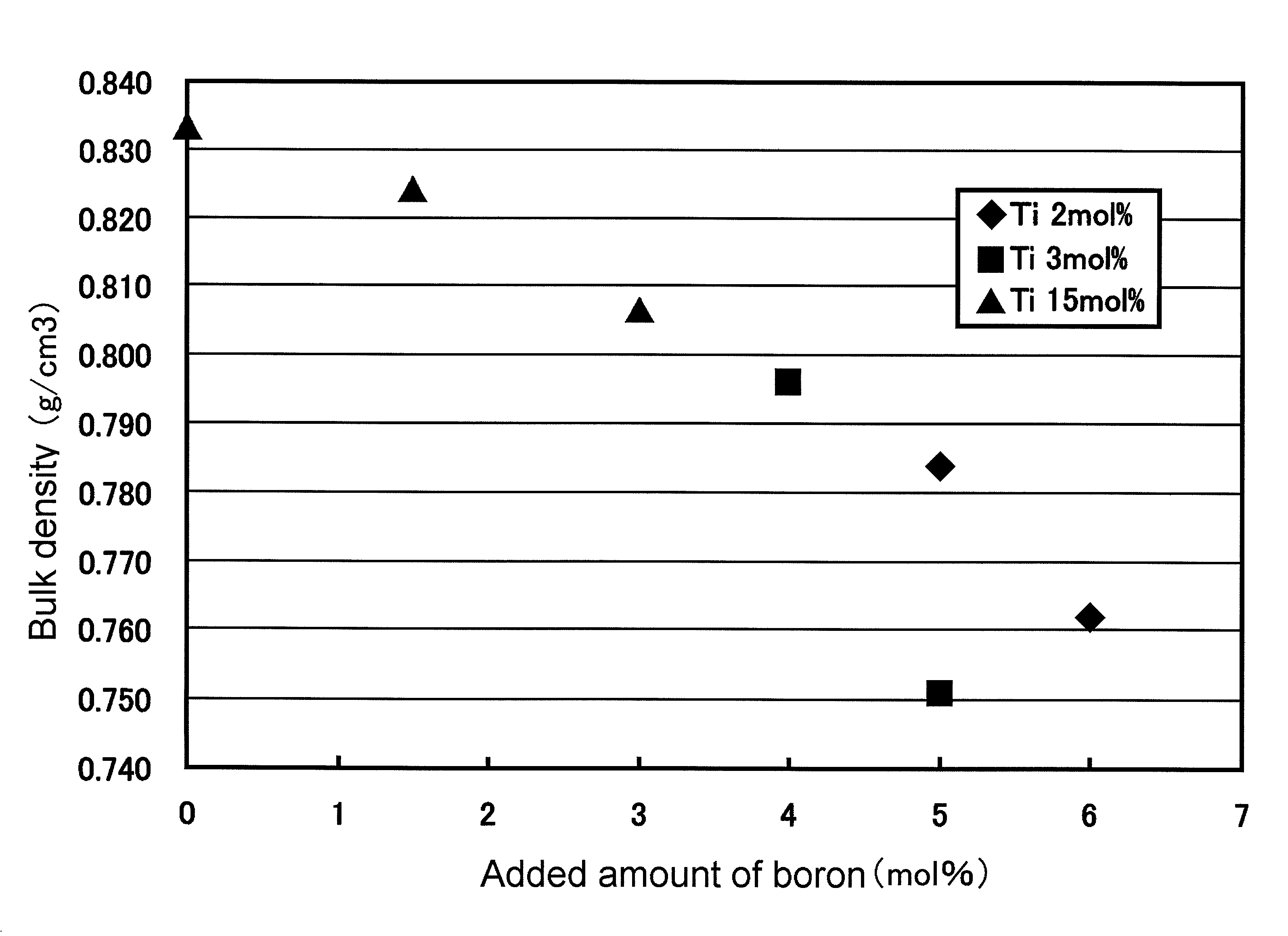Method for manufacturing grin lens
a manufacturing method and lens technology, applied in the field of grin lens manufacturing, can solve the problems of poor yield, cracking or foaming, and sintering and drawing likely to occur, and achieve the effects of sharp improvement of sintering and drawing yield, high porosity, and increased porosity
- Summary
- Abstract
- Description
- Claims
- Application Information
AI Technical Summary
Benefits of technology
Problems solved by technology
Method used
Image
Examples
example 1
[0028]To a mixed liquid of 42.37 g of tetramethoxysilane (TMOS), 1.15 g of tributylborate (B(OBu)3), 17.05 g of ethanol, and 24.37 g of dimethylformamide (DMF), 5.21 g of 0.54 mol / l hydrochloric acid was added, and then the mixture was stirred for 60 minutes.
[0029]DMF is added mainly for leading a fine pore diameter distribution in a dry gel to an appropriate state and is selected as a substance having a dispersibility, a specific gravity, a boiling point, and the like suitable for a solvent. Thus, any substance is used without being limited to the above insofar as the substance brings about equivalent effects. For example, it is considered that EEP (3-ethoxyethyl propionate; boiling point=153° C., specific gravity=0.968) and the like can be used.
[0030]The hydrochloric acid is a substance equivalent to a so-called catalyst to be added in order to appropriately perform a hydrolysis reaction and a polycondensation reaction of alkoxide raw materials and other acids (e.g., acetic acid) ...
example 2
[0040]To a mixed liquid of 47.19 g of tetramethoxy silane (TMOS), 3.84 g of tributylborate (B(OBu)3), 18.57 g of ethanol, and 24.37 g of dimethylformamide (DMF), 5.86 g of 1.53 mol / l hydrochloric acid was added, and the mixture was stirred for 60 minutes. Thereafter, a mixed liquid of 2.27 g of titanium tetra-n-butoxide (Ti(OBu)4), 21.35 g of ethanol, and 12.18 g of DMF was added, and the mixture was stirred while further gradually adding 18.44 g of ethanol and 18.44 g of pure water, thereby obtaining a wet gel (Example 2) containing 93 mol % of silicon, 2 mol % of titanium, and 5 mol % of boron. Similarly, a wet gel containing 6 mol % of boron and 2 mol % of titanium (Example 2-2) was produced. Then, the wet gels were matured at 60° C. for 6 days.
[0041]Thereafter, the wet gels were immersed in 1.53 normal mol / l of hydrochloric acid for 16 hours, leaching was performed by eluting the titanium and the boron from the periphery, and then a concentration distribution of titanium was giv...
PUM
| Property | Measurement | Unit |
|---|---|---|
| density | aaaaa | aaaaa |
| density | aaaaa | aaaaa |
| diameter | aaaaa | aaaaa |
Abstract
Description
Claims
Application Information
 Login to View More
Login to View More - R&D
- Intellectual Property
- Life Sciences
- Materials
- Tech Scout
- Unparalleled Data Quality
- Higher Quality Content
- 60% Fewer Hallucinations
Browse by: Latest US Patents, China's latest patents, Technical Efficacy Thesaurus, Application Domain, Technology Topic, Popular Technical Reports.
© 2025 PatSnap. All rights reserved.Legal|Privacy policy|Modern Slavery Act Transparency Statement|Sitemap|About US| Contact US: help@patsnap.com


